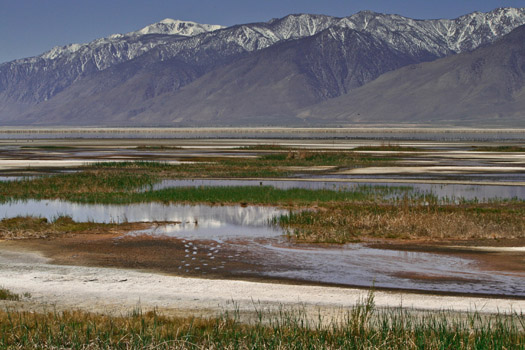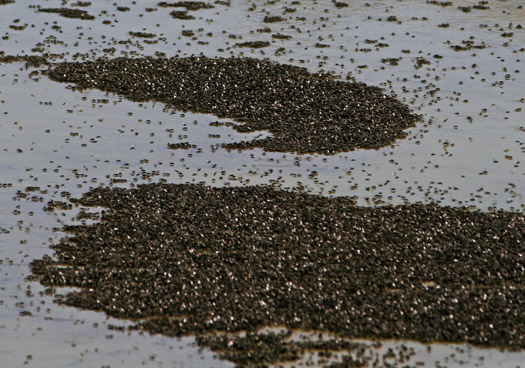Images by Robin Black Photography for the Owens Lake Project, an ongoing photo documentary chronicling the rejuvenation of Owens Lake. See the website for many more. Black comments at DPR – Barcelona:
“No more is it a toxic wasteland, though it’s certainly odd, and occasionally ugly, and still troublesome along the portions deemed too disturbed to recover. Life is returning to the lake, and the future of the ecosystem looks more hopeful than it has in 100 years. It’s vital that people be made aware of the near-miraculous rebirth so that efforts are continued and made permanent. If people continue to believe that the lakebed is a toxic wasteland unworthy of restoration, that’s exactly what it will remain.”
We discovered the Owens Lake Project via Aquifornia.
Barry Lehrman, author of the first chapter of The Infrastructural City, discusses the genesis of the chapter and shares details from both earlier drafts of the chapter and his thesis project, which was to design “an alternate dust mitigation system to restore Owens Lake and create a hybrid landscape for tourism and habitat”, in Writing ‘Infrastructure of the Void’. Lehrman will be posting additional material each day this week, including more details on that design project, “an Owens Lake/Los Angeles Aqueduct bibliography, the Owens Lake Dust Mitigation project team, and a podcast“. As we’ve been discussing parallels between Owens Lake and the Everglades, both here and at F.A.D., Lehrman has also posted a project for the Miami Lakes Belt, “Emergent Urbanism”, which proposes a slightly tongue-in-cheek “Miami Archipelago”.
Free Association Design asks what Owens Lake tells us about the meaning of the term “urban”, and looks at Owens Lake as an example of how twentieth-century infrastructures were produced by a “viscous feedback loop” of “crisis-action-crisis”, in Problematic Surfaces and Collateral Urbanism: Reading into the Owens Lake Parable. A follow-up post, Reconstructing the Void, compares Owens Lake to the Everglades, noting the impossibility of returning such heavily infrastructural landscapes to their pre-anthropogenic condition — which, of course, is not to say that there is no healthier or more ecologically productive future possible.
DPR-Barcelona curates a fantastic selection of photography of Owens Lake, while speculating about leaping From Dust Problems to Towing Icebergs.
FASLANYC lets William Vollmann guide us toward Owens Lake as mythology, concluding with an astonishingly appropriate quote from Italian poet Eugenio Montale: Bring me the sunflower so that I might transplant it into burning fields of alkali, which tells us just about everything we need to know about Owens Lake.
Peter Nunns discusses the strange ecologies of disrupted landscapes outside of LA and Seattle, linking the production of atomic bombs, glow-in-the-dark-feces, toxic dust storms, and the power infrastructure of Los Angeles. In another post, the anti-infrastructural nation, he describes a handful of pieces of New Zealand’s infrastructural history, painting New Zealand’s tendency towards fragmentation and away from centralization as the polar opposite of the southern Californian tendency towards unification and mega-infrastructures.
Nam Henderson considers Owens Lake as a new nature and a frontier, in Preserving the integrity of the void.
Peter Sigrist emphasizes the ethical dimensions of Owens Lake at Polis.
Next Monday, we’ll be discussing David Fletcher’s “Flood Control Freakology”, which explores the ecologies of the highly modified Los Angeles River, as well as Lane Barden’s photo essay, “The River”.
We’ll try to update this post with additional links as more material is posted this week. If you have responded to this week’s chapter and we haven’t added a link here, please let us know via email or in the comments.




Great posting.
btw, I’ll be speaking about my project at Owens Lake (among other topics) at the Annenberg Space for Photography in Los Angeles on Thursday May 20.
[…] with the series, you can start here and catch up here — taking particular note of the index of contributing posts for the first chapter, which tracks the sprawl of the discussion across other […]